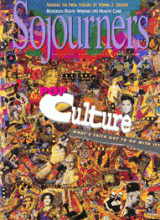We gathered in the courtyard outside the First United Methodist Church in Brevard, North Carolina, just about dusk on Good Friday. A throng of children, women, and men made our way to the fellowship hall by candlelight, walking slowly under hanging plants and past palm branches woven into wooden latticework.
Music from a recorder and a mandolin wafted through the hall, occasionally punctuated by a subtle sweep of chimes or a delicate tap on a drum. Tall bamboo plants adorned the edges of the room lit with oil lamps and candles. A panorama of the Holy Land was projected on one wall.
I had come to this "Early Christian Meal" somewhat reluctantly. But my doubts about how meaningful it could be immediately vanishedmy senses alivened by the simple beauty of the room, the subtlety of the music, and the pleasing aroma of the food.
At the center of each table were a chalice and a plate holding pita bread. Servers, dressed in understated fashion as the early followers of Jesus might have been, brought food in abundanceplatters of baked fish, dishes of rice and vegetables, bowls of freshly sliced fruit. We were invited to imagine ourselves in the home of Joseph of Arimathea just hours after the crucifixion, to converse as the followers of Jesus might have when death seemed to have claimed the life of their beloved leader.
After the meal, seven church members scattered among the crowd rose in turn to offer their Good Friday reflections. The depth and richness of the words they shared were the result of a compelling process in which they had been engaged for several weeks.
Read the Full Article
